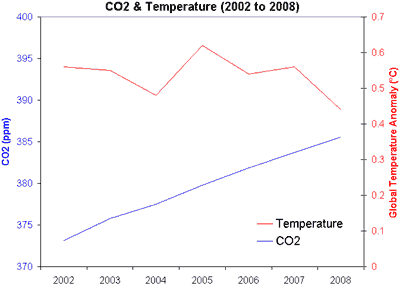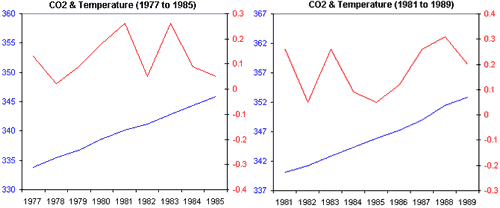
Figure 1: Atmospheric CO2 (parts per million, NOAA) and Global Temperature Anomaly (°C GISS) from 2002 to 2008.
This week, Australian TV channel ABC aired an interview with Australian senator Steve Fielding. The senator is studying both sides of the debate and genuinely seems to be struggling with the question of whether man is causing global warming. He found particularly persuasive the argument that in recent years, global temperatures have been falling while CO2 has been rising.

Figure 1: Atmospheric CO2 (parts per million, NOAA) and Global Temperature Anomaly (°C GISS) from 2002 to 2008.
Temperature shows a slight cooling trend while CO2 has been rising steadily. If CO2 causes warming, shouldn't temperature be rising steadily also? However, if we look at the temperature record over the past several decades, we see that even in a long term warming trend, there are short periods of cooling.

Figure 2: Atmospheric CO2 (parts per million, NOAA) and Global Temperature Anomaly (°C GISS) from 1964 to 2008.
When looking at short periods (eg - less than a decade), climate shows strong variability. Consequently, it's possible to select short periods throughout the long term warming trend where the warming slows or stops. For example, the periods 1977 to 1985 and 1981 to 1989 both show little to no warming while CO2 continues to increase. One might've made the conclusion in 1985 or 1989 that global warming had stopped based on the previous few years data.

Figure 2: Atmospheric CO2 (parts per million, NOAA) and Global Temperature Anomaly (°C GISS) from 1977 to 1985 and 1981 to 1989.
What causes this climate variability? In our last post on ocean heat, we looked at ocean cycles, the most dominant being the El Niño Southern Oscillation. The Pacific Ocean is now in a strong La Niña phase, leading to unusually cool temperatures throughout the tropical Pacific Ocean. Additionally, the sun is currently in solar minimum. Solar activity has an 11 year cycle which is estimated to have an effect of around 0.1°C on global temperatures. The combination of solar minimum and La Niña would have a short term cooling effect on global temperatures.
This example demonstrates the error of drawing conclusions from one small piece of the puzzle without viewing the broader picture. If one focuses on just the last few years, one might erroneously conclude global warming has stopped. However, by looking at a longer data series, we see a climate that shows much short term variability. By understanding some of the mechanisms that cause climate variability, we can see that the current cooling is short term variation imposed on the long term warming trend.
Note: in our next post, we broaden the picture even further, comparing CO2 and temperature back to 1880.
Posted by John Cook on Thursday, 4 June, 2009
 |
The Skeptical Science website by Skeptical Science is licensed under a Creative Commons Attribution 3.0 Unported License. |